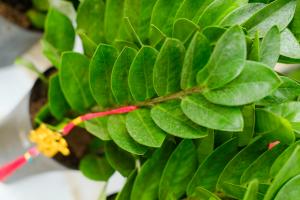How to Stake a Large Tomato Plant
Growing tomatoes is one of the most rewarding experiences for gardeners. They are not only delicious but also easy to grow. However, as the plants grow taller and heavier, they need support to keep the fruit off the ground. In this article, we’ll guide you through the process of staking a large tomato plant.
Step 1: Choose the Right Stake
The first step in staking a large tomato plant is choosing the right stake. You want a stake that is strong enough to support the weight of your plant, so it should be at least four feet tall and made of sturdy materials like bamboo or metal.
Additionally, you should consider the thickness of your plant’s stem. If your tomato stem is larger than two inches in diameter, you may want to opt for a thicker stake to prevent it from bending under the weight of the plant.
Step 2: Hammer the Stake into the Ground
Once you have chosen your stake, you’ll need to hammer it into the ground at least six inches deep. Make sure to place it at least six inches away from the base of your plant to avoid damaging the roots.
Step 3: Tie the Plant to the Stake
The next step is tying your plant to the stake. To do this, you will need garden twine or a soft plant tie. Start by tying a loose knot around the stake about six inches above the ground. Then, gently wrap the string around the stem of your tomato plant, being careful not to tie it too tightly.
Continue wrapping the string around the plant as it grows, tying it to the stake every few inches. Make sure the string is not too tight, as it can damage the stem and stunt the growth of your tomato plant.
Step 4: Prune Your Tomato Plant
To ensure your tomato plant grows strong and healthy, you should prune it regularly. This means removing the suckers that grow in the "V" shape between the main stem and the branches. Suckers divert energy from the main stem and can cause your plant to produce smaller fruit.
Step 5: Maintain Your Staked Tomato Plant
After you have staked and pruned your tomato plant, you need to maintain it properly. Make sure to water it regularly, especially during periods of hot weather. You may also want to fertilize it every few weeks to provide essential nutrients.
Additionally, check your plant’s ties regularly to make sure they are not becoming too tight or digging into the stem. If you notice any issues, adjust the ties immediately to prevent damage to your tomato plant.
Conclusion
Staking a large tomato plant is essential to keep it healthy and productive. Choose a sturdy stake, tie your plant gently, prune your plant regularly, and maintain it properly. By following these steps, you’ll enjoy a bountiful harvest of delicious tomatoes all summer long.

 how many times do yo...
how many times do yo... how many planted tre...
how many planted tre... how many pine trees ...
how many pine trees ... how many pecan trees...
how many pecan trees... how many plants comp...
how many plants comp... how many plants can ...
how many plants can ... how many plants and ...
how many plants and ... how many pepper plan...
how many pepper plan...

































